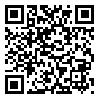Volume 4, Issue 2 (7-2013)
JAP 2013, 4(2): 242-247 |
Back to browse issues page
Download citation:
BibTeX | RIS | EndNote | Medlars | ProCite | Reference Manager | RefWorks
Send citation to:



BibTeX | RIS | EndNote | Medlars | ProCite | Reference Manager | RefWorks
Send citation to:
Goudarzi M, Ebrahim soltani A, Sadrosadat S, Rahimzadeh P, Ziaeefard M. Effect of Single Dose Induction with Halothan on QT Interval in Children. JAP 2013; 4 (2) :242-247
URL: http://jap.iums.ac.ir/article-1-5017-en.html
URL: http://jap.iums.ac.ir/article-1-5017-en.html
Mehrdad Goudarzi 
 , Alireza Ebrahim soltani
, Alireza Ebrahim soltani 
 , Sayedhossein Sadrosadat
, Sayedhossein Sadrosadat 
 , Poupak Rahimzadeh
, Poupak Rahimzadeh 
 , Mohsen Ziaeefard
, Mohsen Ziaeefard 


 , Alireza Ebrahim soltani
, Alireza Ebrahim soltani 
 , Sayedhossein Sadrosadat
, Sayedhossein Sadrosadat 
 , Poupak Rahimzadeh
, Poupak Rahimzadeh 
 , Mohsen Ziaeefard
, Mohsen Ziaeefard 

Abstract: (10311 Views)
Aim and Background: Rapid and Confident induction of anesthesia is a goal for the anesthesiologist. In the meanwhile, most of anesthetic drugs are not without complication. In this study we evaluated the effects of anesthesia induction with halothane by single breath on hemodynamic parameters in pediatric patients.
Methods and Materials: In this study 50 children were enrolled. For induction of anesthesia the single breath method with 5% halothane and O2- N2O (30-70%) mixture was used. Systolic blood pressure, diastolic blood pressure and heart rate were recorded before induction, 1 minute after induction, 1 minute after using muscle relaxant, and 3 minutes after intubation. The heart rate and QT interval were recorded by ECG.
Findings: Halothane significantly prolonged the corrected QT (QTC) it caused a mild increase in heart rate which reduced again after using muscle relaxant. However, another heart rate elevation occurred three minutes after intubation.Blood pressure decreased after induction and even after intubation which was statistically significant.
Conclusions: Halothane is an arrhythmogenic drug which can prolong QTC in pediatric patients. Moreover, our study shows that it can decrease blood pressure and heart rate at the same time.
Type of Study: Original |
Subject:
Pediatrics Anesthesia
Received: 2013.07.8 | Accepted: 2018.12.10 | Published: 2018.12.10
Received: 2013.07.8 | Accepted: 2018.12.10 | Published: 2018.12.10
| Rights and permissions | |
 |
This work is licensed under a Creative Commons Attribution-NonCommercial 4.0 International License. |



